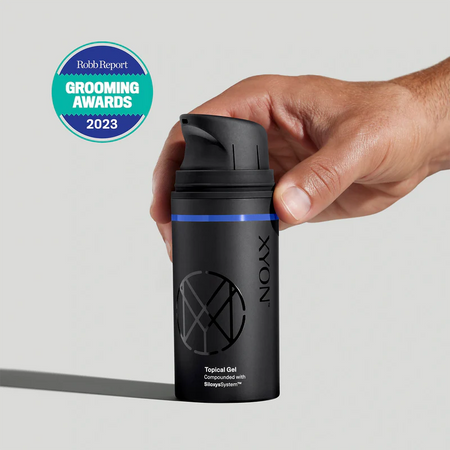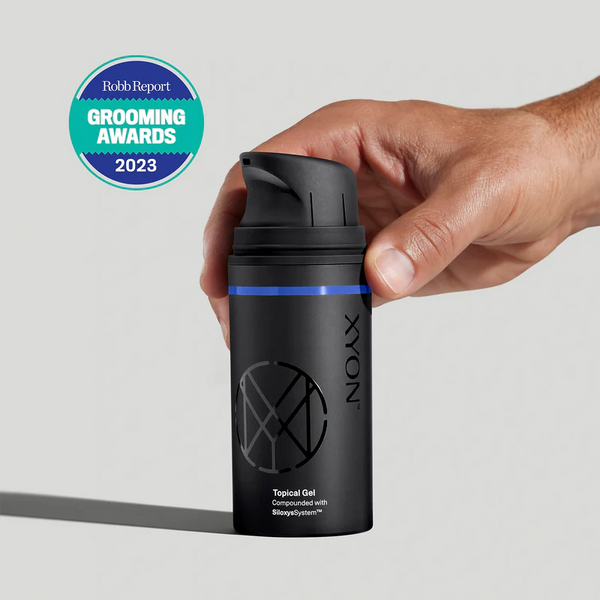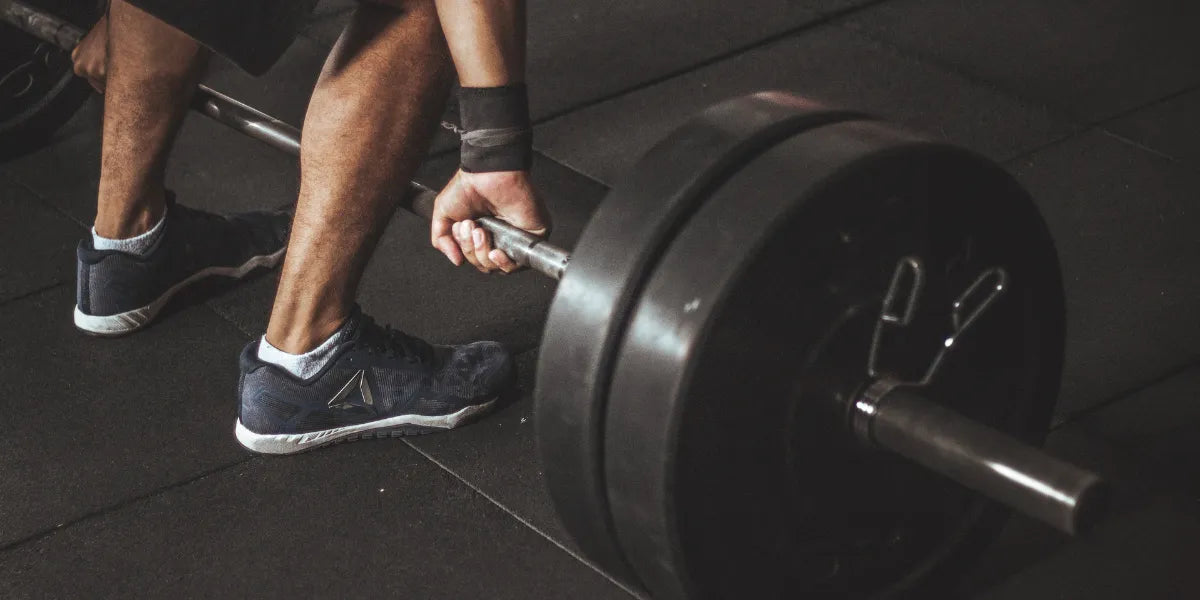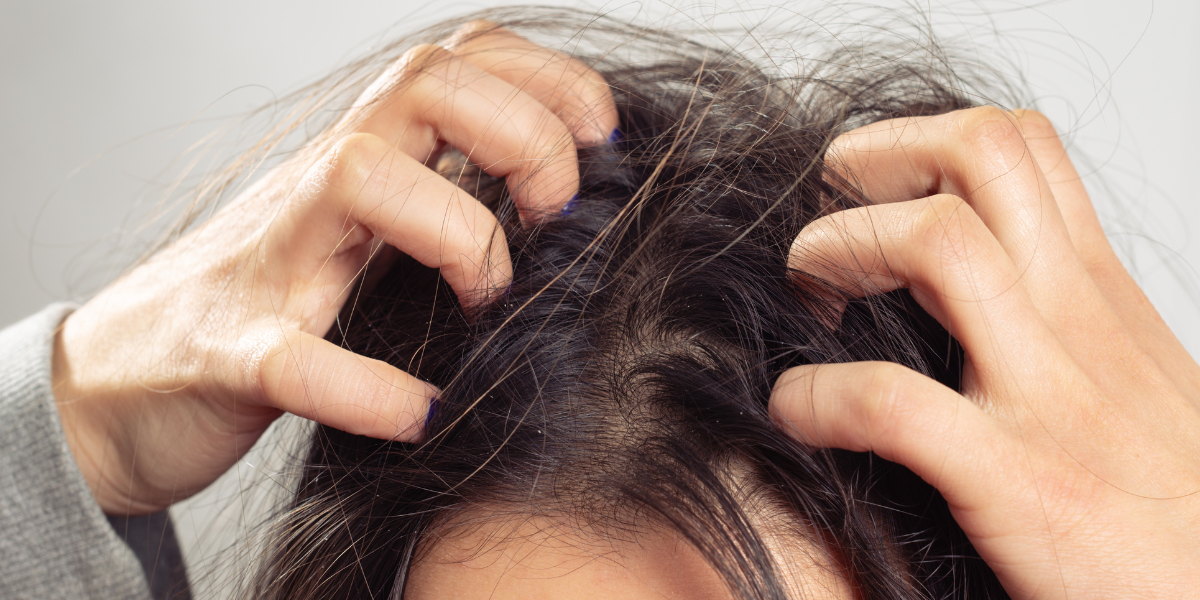Since finasteride interacts with male hormones, concerns have grown around how this drug may impact muscle growth and hinder muscle development. It’s a topic that’s been discussed on various online forums and other platforms. However, the research surrounding this topic is limited and currently, there isn’t enough definitive evidence to support or discount these claims.
Let’s take a closer look at the current data and address the potential muscle effects and muscle-related symptoms of finasteride.
Does finasteride increase testosterone?
Yes, finasteride can increase the levels of circulating testosterone and this is because of its effects on the 5 alpha-reductase enzyme. As a quick refresher, finasteride blocks the activity of the 5 AR enzyme to prevent testosterone from being converted into dihydrotestosterone (DHT). For those genetically susceptible to pattern balding, high levels of DHT at the scalp can cause hair follicles to shrink, eventually causing hair loss. Blocking this conversion helps lower the levels of DHT at the scalp to stop this shrinking from occurring.
Since less testosterone is being converted into DHT, blood levels of testosterone can rise. For example, a study looking at serum testosterone levels before and after finasteride treatment found a significant increase in circulating testosterone, compared to a placebo group (Roehrborn et al, 2003). In another clinical study, men taking finasteride experienced 9-15% higher testosterone levels than the placebo group after being on treatment for 3-12 months (Anitha et al, 2009).
However, these effects can diminish over time. As your body becomes more accustomed to the changes in hormones caused by finasteride, it will typically adjust accordingly by lowering testosterone production. This means the increase in testosterone levels with finasteride is usually temporary.


Side effects while taking oral finasteride? Topical finasteride might be an option.
Minimize the chances of side effects without losing any hair loss stopping benefits.
How does testosterone affect muscle growth?
To understand how and if finasteride interacts with muscle growth, we should first look at the relationship between testosterone and muscle mass. Testosterone is a crucial component of muscle growth and maintenance, playing a key role in the development of proteins and the prevention of protein breakdown, which ultimately contributes to increased muscle growth (Vingren et al, 2010).
Knowing this, as well as the fact that circulating testosterone often rises with finasteride, it would be logical to think that finasteride would enhance muscle growth. But instead, some research has suggested the opposite, with reports of various muscle-related side effects being linked to finasteride use.
Can I build muscle on finasteride?
Whilst there is limited scientific data on this topic, the answer is very likely yes, you can still build muscle on finasteride. One study most relevant to this question investigated muscle mass changes in men taking synthetic testosterone, as well as dutasteride (a similar drug to finasteride). To measure the impact of dutasteride on the muscle mass, a control group was given a placebo in place of dutasteride. Muscle mass was measured throughout the study and in both groups, it increased in a dose-dependent manner with respect to testosterone and there was no difference between the dutasteride and placebo group (Bhasin et al, 2012). This suggests that the 5 alpha-reductase inhibitor dutasteride, which has the same drug action as finasteride, had no impact on muscle mass.
This poses a reasonable argument against finasteride preventing muscle growth, but there are some reports that contradict this. It’s worth mentioning that there is no definitive evidence to support either side of this debate, but let’s take a closer look at the data available.
Can finasteride lead to muscle loss?
It’s possible. The first instance of these reports seems to have come from an observational study in 2016, which looked at men with long-term adverse effects after using finasteride for pattern hair loss (Chiriaco et al, 2016). The study found that roughly half of the patients had reported a loss of muscle mass or tone, as well as 38% experiencing more rigidity in physical movements and involuntary muscle spasms.
Following this, Health Canada conducted a safety review assessing the risk of serious muscle-related side effects associated with finasteride use (Health Canada, 2017). This review revealed 11 Canadian reports of muscle-related side effects on finasteride, but only 4 were deemed to be likely linked to finasteride and thus, assessed further. Of the 4 cases, 1-patient experienced myopathy which refers to a condition affecting the muscle. Another person experienced muscle pain and 2 people had muscle weakness. All 4 of these reported side effects were resolved when the patients stopped taking finasteride.
From this report, Health Canada concluded that the risk of muscle-related side effects with finasteride couldn’t be ruled out and they recommended that manufacturers update the product information to include these potential risks. The drug monograph for finasteride, Propecia®, now includes a mention of rare reports of muscular side effects including rhabdomyolysis, myopathy, myalgia, myasthenia and CK elevation.
Takeaway: does finasteride cause muscle loss?
Despite there being reports and research surrounding finasteride’s possible link to muscle-related symptoms, the scientific and medical communities haven’t reached a consensus about whether the two are linked. Because of this, more research is needed.
If you’re concerned about muscle-related side effects of finasteride, it’s important to keep in mind that these are very rare and early evidence seems to suggest that it’s unlikely that finasteride will prevent you from growing muscle. If you’re still worried or have further questions about finasteride, you can always reach out to one of the hair loss specialists at XYON. They’re more than happy to provide you with the guidance you need to make an informed decision in your hair loss journey.
References
Anitha, B., Inamadar, A.C., Ragunatha, S. (2009). Finasteride-Its impact on sexual function and prostate cancer. Journal of Cutaneous and Aesthetic Surgery, 2(1), 12-16. https://doi.org/10.4103/0974-2077.53093
Bhasin, S., Travison, T.G., Storer, T.W., Lakshman, K., Kaushik, M., Mazer, N.A., Ngyuen, A.H., Davda, M.N., Jara, H., Aakil, A., Anderson, S., Knapp, P.E., Hanka, S., Mohammed, N., Daou, P., Miciek, R., Ulloor, J., Zhang, A., Brooks, B., Orwoll, K., Hede-Brierley, L., Eder, R., Elmi, A., Bhasin, G., Collins, L., Singh, R., Basaria, S. (2012). Effect of testosterone supplementation with and without a dual 5a-reductase inhibitor on fat-free mass in men with suppressed testosterone production: A randomized controlled trial. Laboratory Medicine and Pathology, 307(9), 931-939
Chiriaco, G., Cauci, S., Mazzon, G., Trombetta, C. (2016). An observational retrospective evaluation of 79 young men with long-term adverse effects after use of finasteride against androgenetic alopecia. Andrology, 4(2), 245-250. 10.1111/andr.12147
Health Canada. (2017). Summary safety review – finasteride – assessing the potential risk of serious muscle-related side effects. https://www.canada.ca/en/health-canada/services/drugs-health-products/medeffect-canada/safety-reviews/summary-safety-review-finasteride-assessing-potential-risk-serious-muscle-related-side-effects.html
Roehrborn, C.G., Lee, M., Meehan, A., Waldstreicher, J. (2003). Effects of finasteride on serum testosterone and body mass index in men with benign prostatic hyperplasia. Urology, 62(5), 894-899. https://doi.org/10.1016/s0090-4295(03)00661-7
Vingren, J.L., Kraemer, W.J., Ratamess, N.A., Anderson, J.M., Volek, J.S., Maresh, C.M. (2010). Testosterone physiology in resistance exercise and training: the up-stream regulatory elements. Sports Medicine, 40(12), 1037-1053. https://doi.org/10.2165/11536910-000000000-00000




